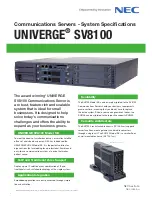
7914DS3KPlanning_090710.fm
Draft Document for Review March 28, 2011 12:24 pm
70
IBM System Storage DS3500: Introduction and Implementation Guide
In mixed workload environments, you must decide which workload type is most critical and
set the system wide settings to best handle your business needs.
Cache flush control settings
In addition to the cache blocksize, the DS3500 also has a cache control, which determines
the amount of data that can be held in write cache. With the
cache flush
settings, you can
determine what level of write cache usage can be reached before the server will start to flush
the data to disk, and at what level the flushing will stop.
By default, these parameters are set to the value of “80” for each, which means that the
server will wait until 80% of the write cache is used before it will flush the data to disk. In a
fairly active write environment, this value might be far too high. You can adjust these settings
up and down until you find a particular value that best suits your environment. If the values
are not the same, then back-end drive inactive time increases, and you have surging with
peaks and valleys occurring instead of a steady usage of back-end disks.
You can also vary the maximum amount of time the write data can remain in cache prior to
being forced out, and written to disks. This value by default is set to ten seconds but can be
changed by using the Storage Manager (SM) command line interface command:
‘set logical Drive [LUN] cacheflushModifier=[new_value];’
3.4 Planning for premium features
The premium features that come with the DS3500 Storage Manager software are enabled by
purchasing a premium feature license key for each feature. When planning for any of the
premium features, it is a good idea to document what are the goals and rationale for
purchasing the feature, which clearly defines from the outset what you want to achieve and
why. There are many different premium features available for different types of expanded
capabilities. The following is a list of the currently available features for the DS3500:
Storage Partitioning
High Performance Tier
Maximum 96 drive support
RAID 6 Logical Drive support
Full Disk Encryption
External Key Management
FlashCopy
VolumeCopy
Enhanced Remote Mirroring
Best Practice: Set the cache blocksize to 8 K for the DS3500, normally for mixed workload
environments.
Tip: Throughput operations, though impacted by smaller cache blocksize, can still perform
reasonably if all other efforts have been accounted for. Transaction based operations are
normally the higher concern, and therefore must be the focus for setting the server wide
values if applicable.
Best practice: Begin with Start/Stop flush settings of 50/50, and adjust from there. Always
keep the values for Start and Stop equal to each other.
Summary of Contents for DS3500
Page 2: ......
Page 5: ...iii Draft Document for Review March 28 2011 12 24 pm 7914edno fm ...
Page 789: ......
















































